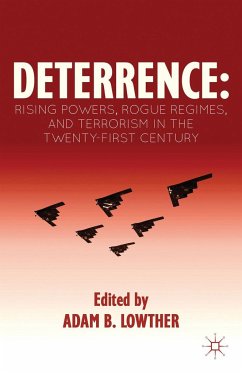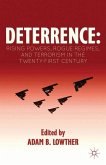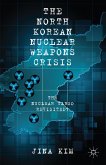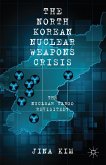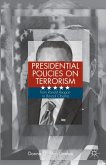Deterrence
Rising Powers, Rogue Regimes, and Terrorism in the Twenty-First Century
Herausgegeben:Lowther, A.
Deterrence
Rising Powers, Rogue Regimes, and Terrorism in the Twenty-First Century
Herausgegeben:Lowther, A.
- Gebundenes Buch
- Merkliste
- Auf die Merkliste
- Bewerten Bewerten
- Teilen
- Produkt teilen
- Produkterinnerung
- Produkterinnerung
This volume moves beyond Cold War deterrence theory to show the many ways in which deterrence is applicable to contemporary security: in space, in cyberspace, and against non-state actors. It also examines the role of nuclear deterrence in the twenty-first century and reaches surprising conclusions.
Andere Kunden interessierten sich auch für
![Deterrence Deterrence]() Deterrence38,99 €
Deterrence38,99 €![Australia and the Bomb Australia and the Bomb]() Christine M. LeahAustralia and the Bomb38,99 €
Christine M. LeahAustralia and the Bomb38,99 €![Great Power Peace and American Primacy Great Power Peace and American Primacy]() J. BaronGreat Power Peace and American Primacy38,99 €
J. BaronGreat Power Peace and American Primacy38,99 €![The North Korean Nuclear Weapons Crisis The North Korean Nuclear Weapons Crisis]() J. KimThe North Korean Nuclear Weapons Crisis38,99 €
J. KimThe North Korean Nuclear Weapons Crisis38,99 €![The North Korean Nuclear Weapons Crisis The North Korean Nuclear Weapons Crisis]() J. KimThe North Korean Nuclear Weapons Crisis38,99 €
J. KimThe North Korean Nuclear Weapons Crisis38,99 €![Presidential Policies on Terrorism Presidential Policies on Terrorism]() D. Starr-DeelenPresidential Policies on Terrorism38,99 €
D. Starr-DeelenPresidential Policies on Terrorism38,99 €![A Nuclear-Weapon-Free World A Nuclear-Weapon-Free World]() Tom MilneA Nuclear-Weapon-Free World38,99 €
Tom MilneA Nuclear-Weapon-Free World38,99 €-
-
-
This volume moves beyond Cold War deterrence theory to show the many ways in which deterrence is applicable to contemporary security: in space, in cyberspace, and against non-state actors. It also examines the role of nuclear deterrence in the twenty-first century and reaches surprising conclusions.
Produktdetails
- Produktdetails
- Verlag: Palgrave Macmillan / Palgrave Macmillan US / Springer Palgrave Macmillan
- Artikelnr. des Verlages: 978-1-137-28979-7
- 2012
- Seitenzahl: 244
- Erscheinungstermin: 28. November 2012
- Englisch
- Abmessung: 216mm x 142mm x 20mm
- Gewicht: 452g
- ISBN-13: 9781137289797
- ISBN-10: 1137289791
- Artikelnr.: 36175820
- Herstellerkennzeichnung
- Libri GmbH
- Europaallee 1
- 36244 Bad Hersfeld
- gpsr@libri.de
- Verlag: Palgrave Macmillan / Palgrave Macmillan US / Springer Palgrave Macmillan
- Artikelnr. des Verlages: 978-1-137-28979-7
- 2012
- Seitenzahl: 244
- Erscheinungstermin: 28. November 2012
- Englisch
- Abmessung: 216mm x 142mm x 20mm
- Gewicht: 452g
- ISBN-13: 9781137289797
- ISBN-10: 1137289791
- Artikelnr.: 36175820
- Herstellerkennzeichnung
- Libri GmbH
- Europaallee 1
- 36244 Bad Hersfeld
- gpsr@libri.de
Adam B. Lowther, Maxwell Air Force Base, Alabama, USA Elbridge Colby, Center For Naval Analysis E. Paul Ratazzi, The Air Force Research Laboratory In Rome, New York, USA Gary Schaub, Jr., University Of Copenhagen, Denmark Kevin R. Beeker, United States Cyber Command, Ft Meade, Maryland, USA Robert F. Mills, The Air Force Institute Of Technology, USA Michael R. Grimaila, The Air Force Institute Of Technology, USA Michael W. Haas, Air Force Research Laboratory, USA Kamal T. Jabbour, Air Force Research Laboratory, Rome, New York, USA Jonathan Trexel, The Strategic Deterrence Assessment Lab Of Science Applications International Corporation Dale Hayden, The Air Force Research Institute Anne Fitzpatrick, Virginia Tech, USA Stephen J. Cimbala, Penn State University-Brandywine, USA James Perry, Northrop Grumman Corporation, USA
Foreword; William A. Chambers 1. How Has Deterrence Evolved?; Adam Lowther PART I: DETERRENCE IN CYBERSPACE 2. Can an Operationally Responsive Cyberspace Play a Critical Role in the Strategic Deterrence Equation?; Kevin R. Beeker, Robert F. Mills, Michael R. Grimaila and Michael W. Haas 3. Does the United States Need a New Model for Cyber Deterrence?; Kamaal T. Jabbour and E. Paul Ratazzi PART II: NUCLEAR DETERRENCE 4. Is Nuclear Deterrence Still Relevant?; Elbridge Colby 5. Can Tailored Deterrence and Smart Power Succeed Against the Long-Term Nuclear Proliferation Challenge?; Jonathan Trexel 6. Is a New Focus on Nuclear Weapons Research and Development Necessary?; Anne Fitzpatrick 7. Missile Defenses and Nuclear Arms Reductions: Can Deterrence Withstand the Attention?; Stephen J. Cimbala PART III: NONTRADITIONAL DETERRENCE 8. Are Rogue Regimes Deterrable?; Gary Schaub 9. How Can the United States Deter Nonstate Actors?; Adam Lowther 10. Is Space Deterrence Science Fiction?; Dale Hayden 11. Can Unmanned Aerial Systems Contribute to Deterrence?; James Perry
Foreword; William A. Chambers 1. How Has Deterrence Evolved?; Adam Lowther PART I: DETERRENCE IN CYBERSPACE 2. Can an Operationally Responsive Cyberspace Play a Critical Role in the Strategic Deterrence Equation?; Kevin R. Beeker, Robert F. Mills, Michael R. Grimaila and Michael W. Haas 3. Does the United States Need a New Model for Cyber Deterrence?; Kamaal T. Jabbour and E. Paul Ratazzi PART II: NUCLEAR DETERRENCE 4. Is Nuclear Deterrence Still Relevant?; Elbridge Colby 5. Can Tailored Deterrence and Smart Power Succeed Against the Long-Term Nuclear Proliferation Challenge?; Jonathan Trexel 6. Is a New Focus on Nuclear Weapons Research and Development Necessary?; Anne Fitzpatrick 7. Missile Defenses and Nuclear Arms Reductions: Can Deterrence Withstand the Attention?; Stephen J. Cimbala PART III: NONTRADITIONAL DETERRENCE 8. Are Rogue Regimes Deterrable?; Gary Schaub 9. How Can the United States Deter Nonstate Actors?; Adam Lowther 10. Is Space Deterrence Science Fiction?; Dale Hayden 11. Can Unmanned Aerial Systems Contribute to Deterrence?; James Perry

